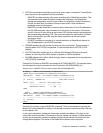
Chapter 24. Global Mirror interfaces 305
For redundancy reasons it is better to define two paths between the primary disk subsystems.
Note that the FCP ports may be shared using a SAN fabric. See Figure 24-3.
24.3.3 Establish Global Copy volume pairs
After defining the paths, you create the Global Copy volume pairs.
Figure 24-4 Establish a Global Copy pair
Figure 24-4 illustrates a Global Copy pair relationship between the primary A volume and the
secondary B volume. This relationship is maintained over the four logical paths that connect
the corresponding LSSs. These paths were defined in Example 24-9 on page 303.
Example 24-10 shows the TSO command used to define the Global Copy pair relationship.
Example 24-10 Define Global Copy pair relationship using TSO command
//* ---------------------------- TSO ------------ CREATE (2) ----- ***
//* ESTABLISH GLOBAL COPY PAIR(S) ***
//* -------------------------------------------------------------- ***
//EPAIR EXEC PGM=IKJEFT01
//SYSPRINT DD SYSOUT=*
//SYSTSPRT DD SYSOUT=*
//SYSTSIN DD DDNAME=SYSIN
CESTPAIR DEVN (X'2C01') +
PRIM (X'2C00' 27131 X'01' X'0C') +
SEC (X'3C00' 73081 X'01' X'0C') +
ONLINSEC(NO) MSGREQ(NO) CRIT(NO) +
OPTION (XD) MODE (COPY) CASCADE(NO)
OPTION(XD) indicates a Global Copy relationship. Once the command successfully ends,
Global Copy immediately does an initial copy of the primary volumes. Example 24-11 on
page 306 shows the output information from a query command to the primary volume. You
can see the pending.XD volume state, and the number of tracks out of sync, all of which is
expected for a Global Copy pair relationship that is in its initial replication phase.
LCU: 2C00
Primary
A
2C00
LCU: 3C00
Secondary
B
3C00
e
s
t
a
b
l
i
s
h
G
l
o
b
a
l
C
o
p
y
p
a
i
r
logical paths
connecting LSSs


















